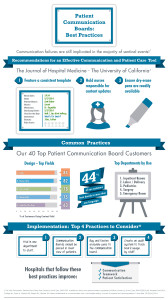I have been working with healthcare providers for over 20 years and, fortunately, I haven’t had to view care from the patient’s perspective very often. We all talk about the importance of engaging patients, improving communication and patient safety but all of those terms become increasing more important, and more personal, when it is you or a family member.
Last year, I had two knee replacement surgeries that involved a few days in the hospital. Although I had attended a class at the hospital on what to expect before, during and after my surgery and had received detailed pre-op instructions, I had many questions and some anxiety when I got out of surgery. Who is my nurse? When will I see my surgeon? What are my medications? What is my plan and goal for each day in the hospital? When will I be discharged?
Engaging Patients and Families in Care
 Poor communications cause many problems. However, the recently published report of the National Patient Safety’s Lucian Leape Institute, “Safety is Personal,” stresses that by engaging patients and families there’s an opportunity to reduce the potential for harm and enhance the overall care experience. Nonetheless, there are considerable barriers to engagement. As the report notes, “Many of the barriers to engagement faced by patients and families – such as lack of access to their health records, intimidation, fear of retribution, and lack of easy-to-understand tools and checklists for enhancing safe care – can only be overcome if leaders and clinicians support patients and families to become more confident and effective in their interactions with health care providers.”
Poor communications cause many problems. However, the recently published report of the National Patient Safety’s Lucian Leape Institute, “Safety is Personal,” stresses that by engaging patients and families there’s an opportunity to reduce the potential for harm and enhance the overall care experience. Nonetheless, there are considerable barriers to engagement. As the report notes, “Many of the barriers to engagement faced by patients and families – such as lack of access to their health records, intimidation, fear of retribution, and lack of easy-to-understand tools and checklists for enhancing safe care – can only be overcome if leaders and clinicians support patients and families to become more confident and effective in their interactions with health care providers.”
Creating Effective Interactions
One communication strategy that has become increasingly popular is placing whiteboards in patient rooms. They provide a convenient vehicle for answering the many questions patients and their families have during their stay and for displaying a wide range of information. Both Kaiser Permanente’s Nurse Knowledge Exchange program and the Institute for Healthcare Improvement’s Transforming Care at the Bedside have promoted their use. I recall seeing a whiteboard in the room I stayed after my surgery. Unfortunately, much of the writing was illegible and the whiteboard didn’t provide any meaningful information about the plan for my stay or the status of my condition.
In 2010, The Journal of Hospital Medicine published results of a survey conducted by the University of California, San Francisco (UCSF) on the use of patient whiteboards as a means of communication in the hospital. Bedside nurses, internal medicine housestaff and hospitalists were surveyed to help UCSF establish guidelines for whiteboard use. All respondents agreed whiteboards could improve teamwork, communication and patient care. The survey confirmed that nurses were more likely to use and read the whiteboards than physicians, and most respondents recommended bedside nurses be responsible for keeping whiteboard information updated and accurate. UCSF nurses, who see themselves as patient advocates, strongly believed the whiteboard should include a “goal for the day” and an “anticipated discharge date.” The majority of respondents felt the goal for the day should be created by the physician and bedside nurse ( though UCSF ultimately opted for a more patient-centered approach that invited the patient to help establish the goal). All respondents believed family contact information was useful and should be included on the whiteboard. From an operational perspective, most respondents agreed that using templated whiteboards with predefined fields for content would increase the use of the whiteboards, and they indicated that the greatest barrier to using whiteboards was not having pens readily accessible.
Plan, Monitor, Evaluate
Based on the UCSF survey and experience, it’s clear patient whiteboards require clearly defined goals, thoughtful planning and ongoing evaluation to assure a smooth rollout and to look for opportunities to improve their effectiveness in driving safer care and a better patient experience. Below is a visual summary of best practices UCSF identified for using the patient whiteboard effectively along with some interesting data I compiled, showing how 40 top healthcare providers are using whiteboards to improve patient communications.
Closing Communication Gaps
At a time when technology has taken center stage, a tool as simple as a patient whiteboard can be easily overlooked or underrated. Yet, there’s power in that simplicity, allowing hospitals to better engage patients, address relevant patient safety issues and close communication gaps between providers and their patients and families. Moreover, by customizing them for various service lines — inpatient rooms, labor and delivery, pediatrics, surgery and emergency, etc. — hospitals have the opportunity to engage patients in meaningful ways, specific to their condition.





